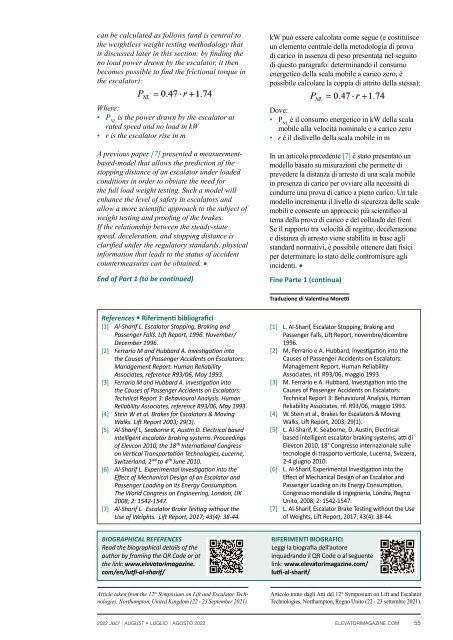Elevatori Magazine 4 2022
July / August
July / August
Create successful ePaper yourself
Turn your PDF publications into a flip-book with our unique Google optimized e-Paper software.
can be calculated as follows (and is central to<br />
the weightless weight testing methodology that<br />
is discussed later in this section: by finding the<br />
no load power drawn by the escalator, it then<br />
becomes possible to find the frictional torque in<br />
the escalator):<br />
kW può essere calcolata come segue (e costituisce<br />
un elemento centrale della metodologia di prova<br />
di carico in assenza di peso presentata nel seguito<br />
di questo paragrafo: determinando il consumo<br />
energetico della scala mobile a carico zero, è<br />
possibile calcolare la coppia di attrito della stessa):<br />
Where:<br />
• P NL<br />
is the power drawn by the escalator at<br />
rated speed and no load in kW<br />
• r is the escalator rise in m<br />
A previous paper [7] presented a measurementbased-model<br />
that allows the prediction of the<br />
stopping distance of an escalator under loaded<br />
conditions in order to obviate the need for<br />
the full load weight testing. Such a model will<br />
enhance the level of safety in escalators and<br />
allow a more scientific approach to the subject of<br />
weight testing and proofing of the brakes.<br />
If the relationship between the steady-state<br />
speed, deceleration, and stopping distance is<br />
clarified under the regulatory standards, physical<br />
information that leads to the status of accident<br />
countermeasures can be obtained. •<br />
End of Part 1 (to be continued)<br />
Dove:<br />
• P NL<br />
è il consumo energetico in kW della scala<br />
mobile alla velocità nominale e a carico zero<br />
• r è il dislivello della scala mobile in m<br />
In un articolo precedente [7] è stato presentato un<br />
modello basato su misurazioni che permette di<br />
prevedere la distanza di arresto di una scala mobile<br />
in presenza di carico per ovviare alla necessità di<br />
condurre una prova di carico a pieno carico. Un tale<br />
modello incrementa il livello di sicurezza delle scale<br />
mobili e consente un approccio più scientifico al<br />
tema della prova di carico e del collaudo dei freni.<br />
Se il rapporto tra velocità di regime, decelerazione<br />
e distanza di arresto viene stabilito in base agli<br />
standard normativi, è possibile ottenere dati fisici<br />
per determinare lo stato delle contromisure agli<br />
incidenti. •<br />
Fine Parte 1 (continua)<br />
Traduzione di Valentina Moretti<br />
References • Riferimenti bibliografici<br />
[1] Al-Sharif L. Escalator Stopping, Braking and<br />
Passenger Falls. Lift Report, 1996. November/<br />
December 1996.<br />
[2] Ferrario M and Hubbard A. Investigation into<br />
the Causes of Passenger Accidents on Escalators:<br />
Management Report. Human Reliability<br />
Associates, reference R93/06, May 1993.<br />
[3] Ferrario M and Hubbard A. Investigation into<br />
the Causes of Passenger Accidents on Escalators:<br />
Technical Report 3: Behavioural Analysis. Human<br />
Reliability Associates, reference R93/06, May 1993.<br />
[4] Stein W et al. Brakes for Escalators & Moving<br />
Walks. Lift Report 2003; 29(1).<br />
[5] Al-Sharif L, Seaborne K, Austin D. Electrical based<br />
intelligent escalator braking systems. Proceedings<br />
of Elevcon 2010, the 18th International Congress<br />
on Vertical Transportation Technologies, Lucerne,<br />
Switzerland, 2nd to 4th June 2010.<br />
[6] Al-Sharif L. Experimental Investigation into the<br />
Effect of Mechanical Design of an Escalator and<br />
Passenger Loading on its Energy Consumption.<br />
The World Congress on Engineering, London, UK<br />
2008; 2: 1542-1547.<br />
[7] Al-Sharif L. Escalator Brake Testing without the<br />
Use of Weights. Lift Report, 2017; 43(4): 38-44.<br />
[1] L. Al-Sharif, Escalator Stopping, Braking and<br />
Passenger Falls, Lift Report, novembre/dicembre<br />
1996.<br />
[2] M. Ferrario e A. Hubbard, Investigation into the<br />
Causes of Passenger Accidents on Escalators:<br />
Management Report, Human Reliability<br />
Associates, rif. R93/06, maggio 1993.<br />
[3] M. Ferrario e A. Hubbard, Investigation into the<br />
Causes of Passenger Accidents on Escalators:<br />
Technical Report 3: Behavioural Analysis, Human<br />
Reliability Associates, rif. R93/06, maggio 1993.<br />
[4] W. Stein et al., Brakes for Escalators & Moving<br />
Walks, Lift Report, 2003; 29(1).<br />
[5] L. Al-Sharif, K. Seaborne, D. Austin, Electrical<br />
based intelligent escalator braking systems, atti di<br />
Elevcon 2010, 18° Congresso internazionale sulle<br />
tecnologie di trasporto verticale, Lucerna, Svizzera,<br />
2-4 giugno 2010.<br />
[6] L. Al-Sharif, Experimental Investigation into the<br />
Effect of Mechanical Design of an Escalator and<br />
Passenger Loading on its Energy Consumption,<br />
Congresso mondiale di ingegneria, Londra, Regno<br />
Unito, 2008; 2: 1542-1547.<br />
[7] L. Al-Sharif, Escalator Brake Testing without the Use<br />
of Weights, Lift Report, 2017; 43(4): 38-44.<br />
BIOGRAPHICAL REFERENCES<br />
Read the biographical details of the<br />
author by framing the QR Code or at<br />
the link: www.elevatorimagazine.<br />
com/en/lutfi-al-sharif/<br />
RIFERIMENTI BIOGRAFICI<br />
Leggi la biografia dell’autore<br />
inquadrando il QR Code o al seguente<br />
link: www.elevatorimagazine.com/<br />
lutfi-al-sharif/<br />
Article taken from the 12 th Symposium on Lift and Escalator Technologies,<br />
Northampton, United Kingdom (22 - 23 September 2021).<br />
Articolo tratto dagli Atti del 12° Symposium on Lift and Escalator<br />
Technologies, Northampton, Regno Unito (22 - 23 settembre 2021).<br />
<strong>2022</strong> JULY | AUGUST • LUGLIO | AGOSTO <strong>2022</strong><br />
ELEVATORIMAGAZINE.COM<br />
55














